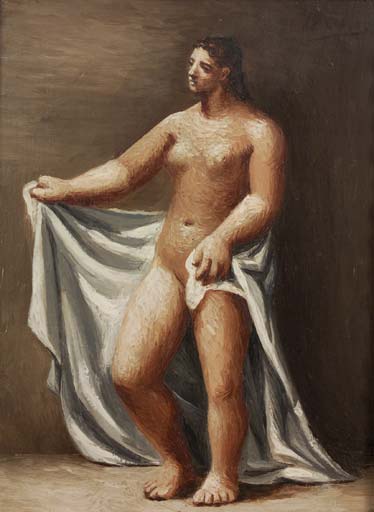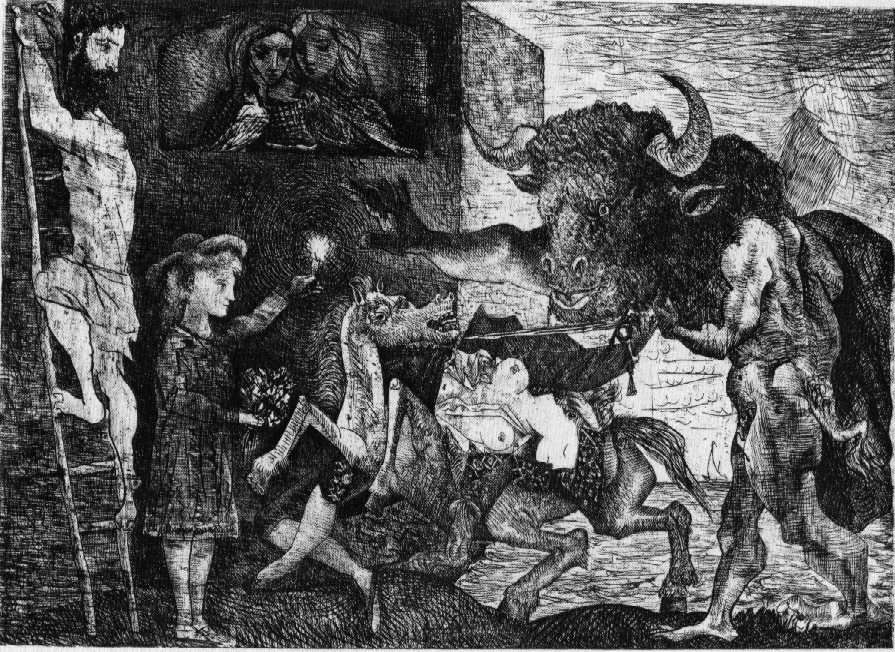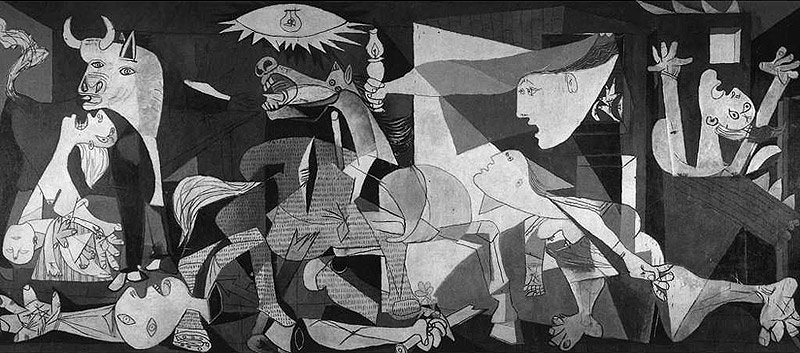It has been as impossible for Picasso to dissociate his art from the human values that art has traditionally served, as it has been for him to imitate traditional forms. He was the most extraordinary artist of the twentieth century in being at once uncompromisingly revolutionary and traditional. He was the most aggressive spokesman for the present, but crossed repeatedly the boundary of the moment into the prophecy or creation of the immediate future.Yet, he never questioned the validity or the eternal presence of the past and his inescapable origins within it. Picasso appears less than half understood if the foundations of tradition are ignored beneath the dazzling contemporary structure that he added to them.

Picasso. The Bather. 1922. During the early 1920's Picasso made an unexpected shift of manner for an artist identified with revolution.He returned to calssical forms, weighty and specifically defined.
In a spirit of play, Picasso did drawings and paintings, that through no fault of his own, were distorted by efforts to read more than play into them. Any line he put on paper brought a high price and publicity, but neither the price nor the disproportionate attention meant that he was doing anything more than what any good artist did; commenting on life as he saw it, felt it and lived it. Picasso saw, felt and lived with extraordinary intensity and liveliness at all levels from passion to horseplay, from philosophical brooding upon the human condition to unquestioning, extroverted gusto for the commonest diversions. By the evidence of the work that poured from him for so many years, anything he saw, felt or did was for Picasso incomplete as an experience until it had been released and recorded, whether as a sketch noted down in a few seconds or a work like ”Guernica”, certainly his masterpiece, with its 296 square feet of canvas resolved from hundreds of preliminary drawings and studies.
In its great size, in its climactic harmonizing of the innovational and traditional sources of modern art, in its intellectualand emotional passion, and in its iconographical summation of a tragedy at the heart of the artist’s century, ”Guernica” is a masterpiece in the grand manner, specific in its references but universal through their interpretation. ”Guernica” refutes not only the mortal charge against modern art but also the defense made by artists and critics against this charge. The charge is that modern art has relinquished its function as interpreter of the ideas people hold, as the clarifier and intensfier of human experience; that it has become fragmentary, hyper-personal, withdrawn from life, and mute for all but an inner circle which substitutes an esoteric retreat for the vitality of true experience.
The defense offered is that in a time in which the world is so complicated that no person can hope to understand it, art can be nothing but fragmentary. Hence, when the world is directed by forces of destruction, the artist can be creative only in the area where one thing, at least, is certain, which is the personal, and the private enjoyment of abstract speculations in a retreat where it is possible to mark time pending the arrival of Armageddon or the horsemen of the Apocalypse. But ”Guernica” accepts no withdrawal, and instead of accepting defeat it challenges the victors. It is not an elegy, but an indictment.
The immediate inspiration for ”Guernica” was the bombing of thatcity during the Spanish civil war. Fort-five days after the event Picasso had completed the great canvas in which he combined the immediate expression of fury and anguish as a personal reaction to a tragic crime with an intellectually disciplined presentation in a way not quite paralleled elsewhere in the history of painting. ”Guernica” is as volatile in effect as if it had been produced under blind inspiration. But, in its pictorial structure it is firmly calculated; as if constructed at leisure over an unlimited period of contemplation and analysis. There is nothing in ”Guernica” as a pure structure that need be pardoned or justified by the overpowering urgency of its creation. Nor is there any sacrifice of energy that must be justified by claiming it was necessary to the creation of a timeless statement.
The event that inspired ”Guernica” was quickly dwarfed by mass horror that was inconceivable when it was painted. A lesser painting would have been reduced to inconsequence by this shift of perspective and scale. Museum basements are filled with battle paintings that no longer touch us. ”Guernica” though, does not depend on corollary historical interest. If it did, it would have died entirely, since it is an imagined scene presented in abstract symbols, with no reference to historical fact. And it cannot stir by association the shock and terror of an event that few people would recognize by name if Picasso had not immortalized that name. The tables are turned. If we continue to feel shock at the bombing of Guernica, a relatively small bombing compared to Dresden or Nagasaki, the shock is kept alive by association with the painting, which shocks by its own power.







 COMMENTS
COMMENTS